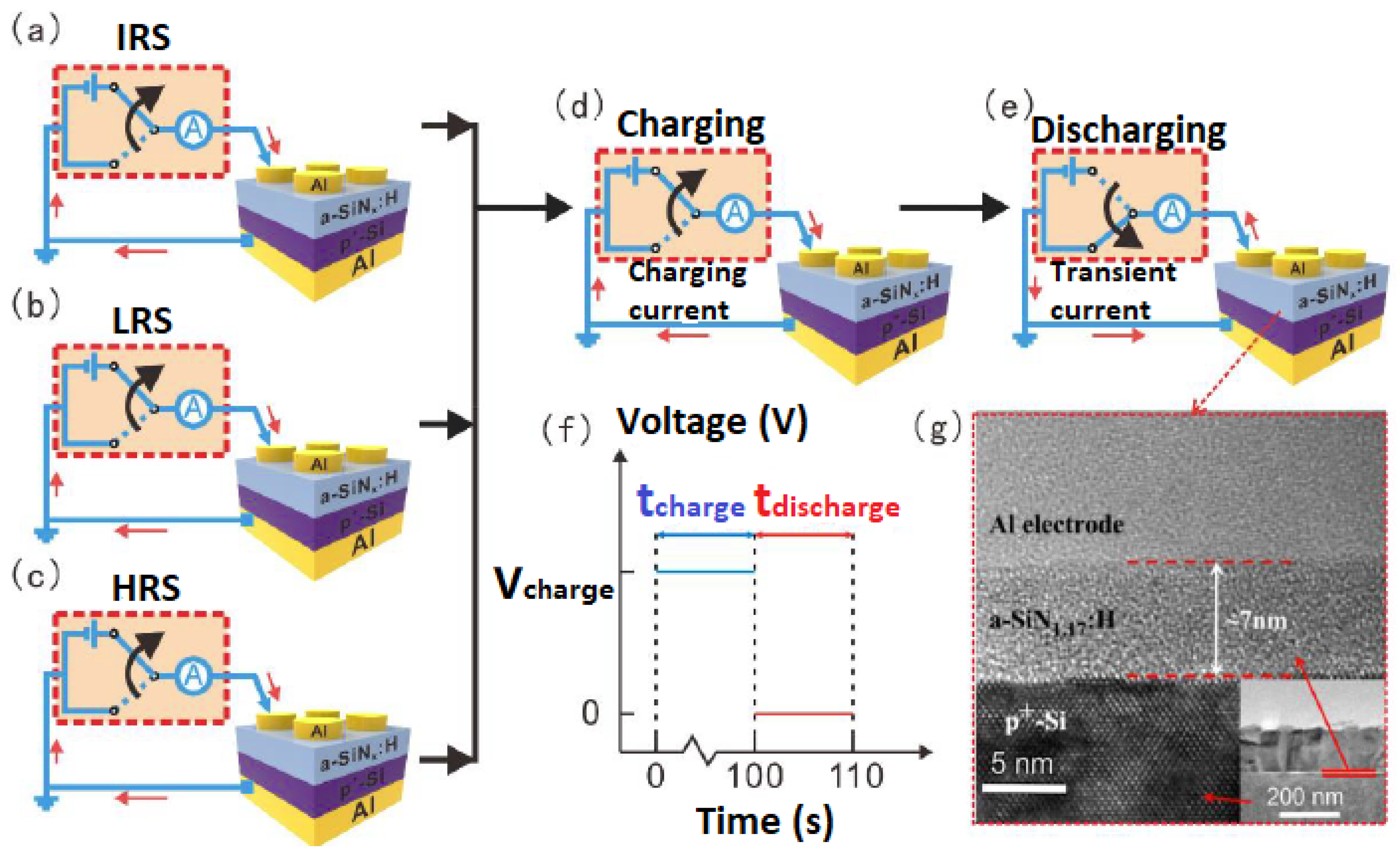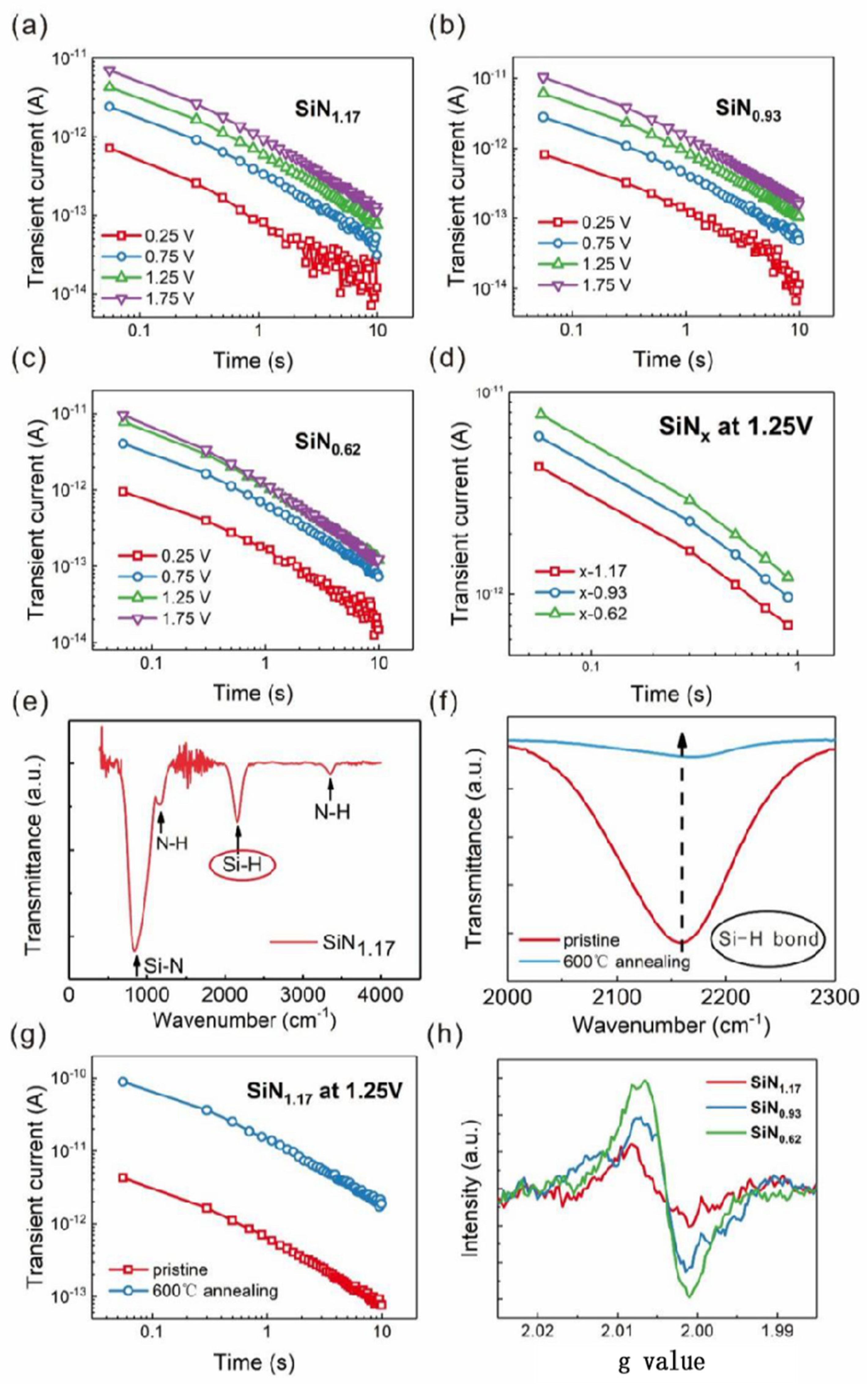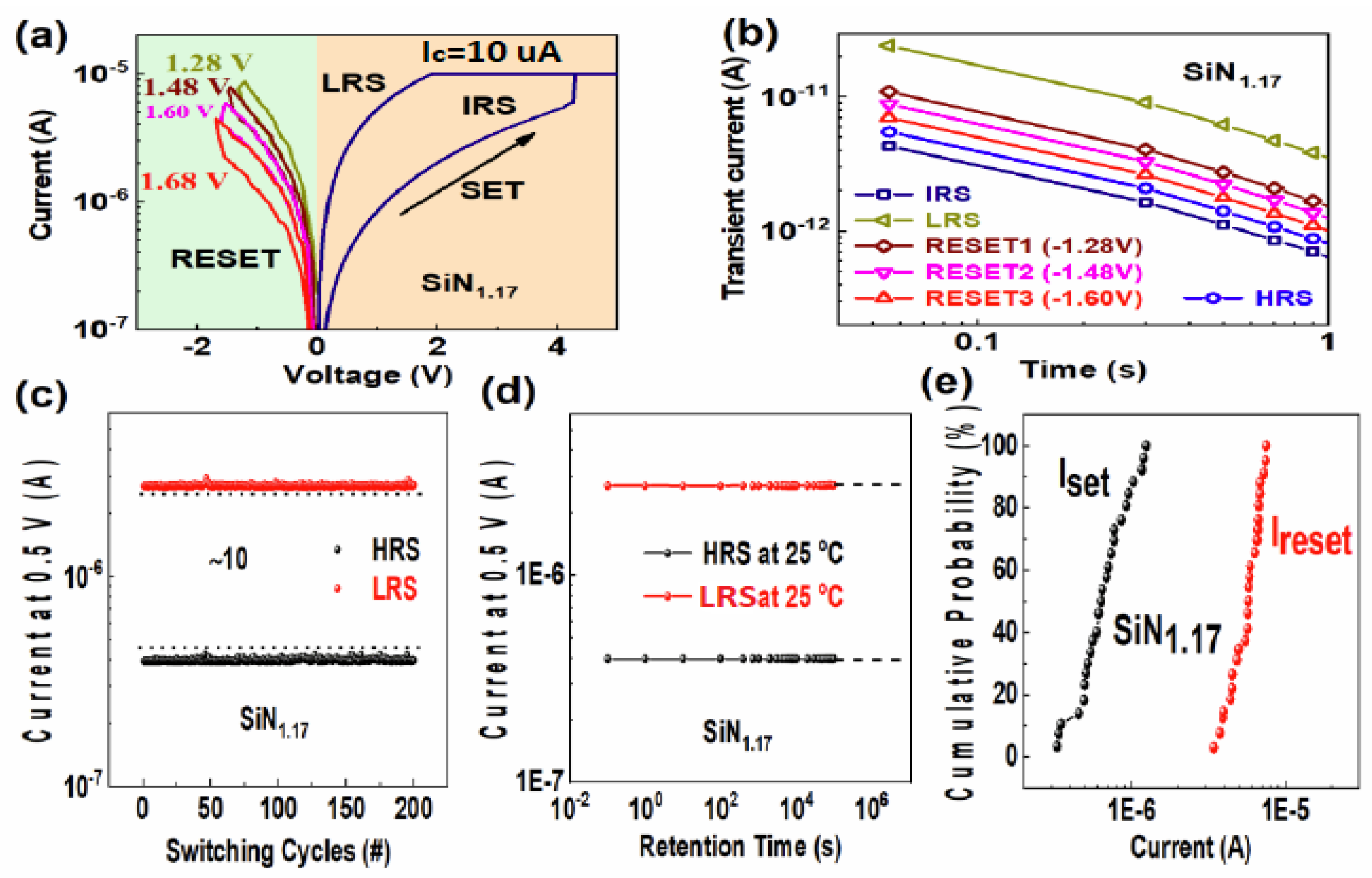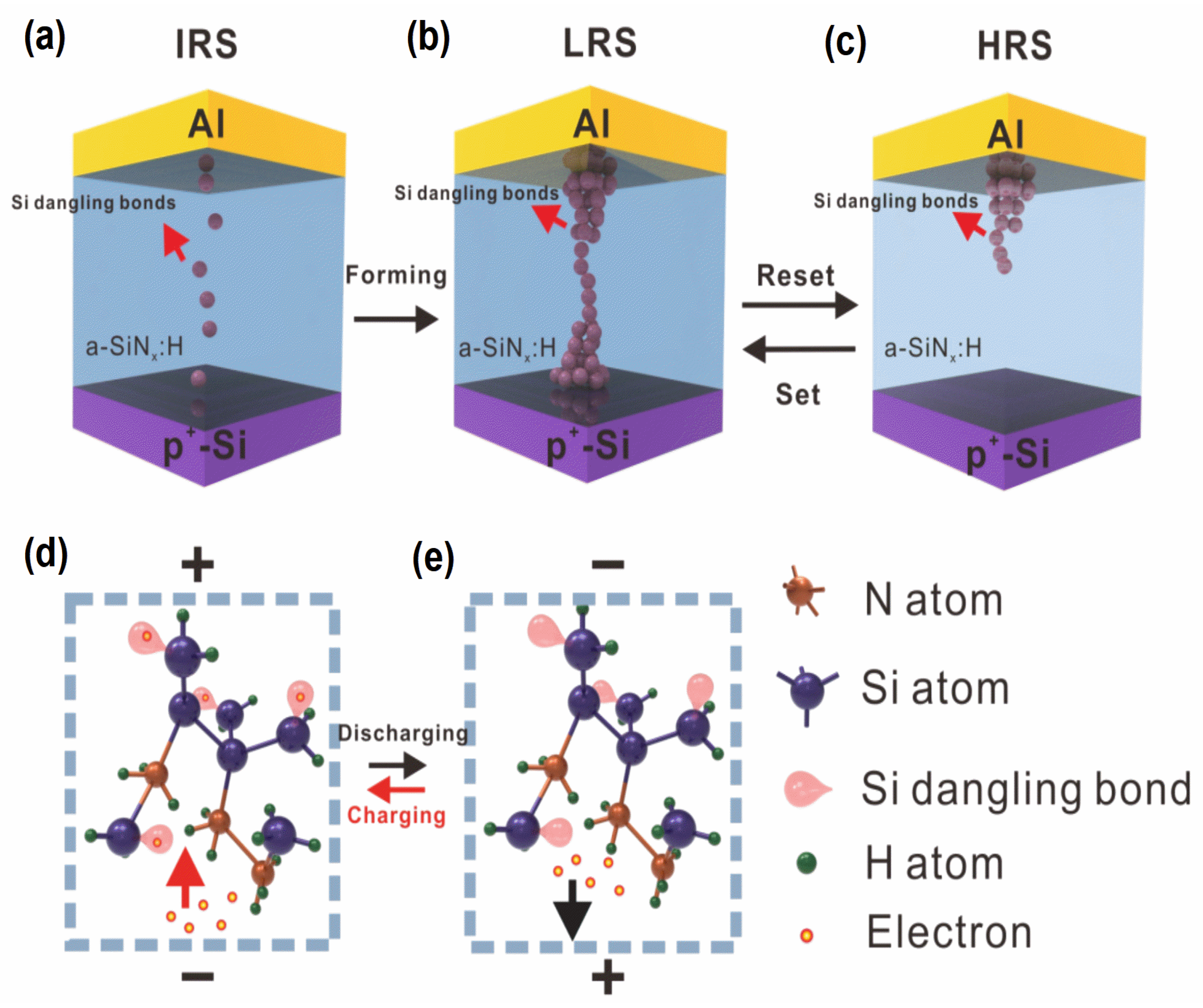Tracing the Si Dangling Bond Nanopathway Evolution ina-SiNx:H Resistive Switching Memory by the Transient Current
Abstract
:1. Introduction
2. Materials and Methods
3. Results
4. Conclusions
Author Contributions
Funding
Institutional Review Board Statement
Informed Consent Statement
Data Availability Statement
Conflicts of Interest
References
- Yang, Y.; Huang, R. Probing Memristive Switching in Nanoionic Devices. Nat. Electron. 2018, 5, 274–287. [Google Scholar] [CrossRef]
- Yang, Y.; Zhang, X.; Qin, L.; Zeng, Q.; Qiu, X.; Huang, R. Probing Nanoscale Oxygen Ion Motion in Memristive Systems. Nat. Commun. 2017, 8, 15173. [Google Scholar] [CrossRef] [PubMed] [Green Version]
- Yan, X.; Zhao, J.; Liu, S.; Zhou, Z.; Liu, Q.; Chen, J.; Liu, X.Y. Memristor with Ag-Cluster-Doped TiO2 Films as Artificial Synapse for Neuroinspired Computing. Adv. Funct. Mater. 2018, 28, 1705320. [Google Scholar] [CrossRef]
- Zhang, Y.; Yang, T.; Yan, X.; Zhang, Z.; Bai, G.; Lu, C.; Jia, X.; Ding, B.; Zhao, J.; Zhou, Z. A Metal/Ba0.6Sr0.4TiO3/SiO2/Si Single Film Device for Charge Trapping Memory Towards a Large Memory Window. Appl. Phys. Lett. 2017, 110, 223501. [Google Scholar] [CrossRef]
- Hong, S.M.; Kim, H.D.; An, H.M.; Kim, T.G. Effect of Work Function Difference Between Top and Bottom Electrodes on The Resistive Switching Properties of SiN Films. IEEE Electron. Dev. Lett. 2013, 34, 1181–1183. [Google Scholar] [CrossRef]
- Kwon, J.Y.; Park, J.H.; Kim, T.G. Self-rectifying Resistive-switching Characteristics with Ultralow Operating Currents in SiOxNy/AlN Bilayer Devices. Appl. Phys. Lett. 2015, 106, 223506. [Google Scholar] [CrossRef]
- Kim, H.D.; An, H.M.; Hong, S.M.; Kim, T.G. Forming-free SiN-based Resistive Switching Memory Prepared by RF Sputtering. Phys. Status Solidi A 2013, 210, 1822–1827. [Google Scholar] [CrossRef]
- Jiang, X.; Ma, Z.; Yang, H.; Yu, J.; Wang, W.; Zhang, W.; Feng, D. Nanocrystalline Si Pathway Induced Unipolar Resistive Switching Behavior From Annealed Si-rich SiNx/SiNy Multilayers. J. Appl. Phys. 2014, 116, 123705. [Google Scholar] [CrossRef]
- Kim, H.D.; An, H.M.; Hong, S.M.; Kim, T.G. Unipolar Resistive Switching Phenomena in Fully Transparent SiN-based Memory Cells. Semicond. Sci. Technol. 2012, 27, 125020. [Google Scholar] [CrossRef]
- Kim, S.; Chang, Y.F.; Kim, M.H.; Park, B.G. Improved Resistive Switching Characteristics in Ni/SiNx/p++-Si Devices by Tuning x. Appl. Phys. Lett. 2017, 111, 033509. [Google Scholar] [CrossRef]
- Kim, S.; Park, B.G. Tuning Tunnel Barrier in Si3N4-based Resistive Memory Embedding SiO2 for Low-power and High-density Cross-point Array Applications. J. Alloy. Compd. 2016, 663, 256–261. [Google Scholar] [CrossRef]
- Jiang, X.; Ma, Z.; Xu, J.; Chen, K.; Xu, L.; Li, W.; Feng, D. a-SiNx: H-based Ultra-low Power Resistive Random Access Memory with Tunable Si Dangling Bond Conduction Paths. Sci. Rep. 2015, 5, 15762. [Google Scholar] [CrossRef] [PubMed] [Green Version]
- Dumin, D.J.; Maddux, J.R. Correlation of Stress-induced Leakage Current in Thin Oxides with Trap Generation Inside the Oxides. IEEE Trans. Electron. Dev. 1993, 40, 986–993. [Google Scholar] [CrossRef]
- Scott, R.S.; Dumin, D.J. The Charging and Discharging of High-voltage Stress-generated Traps in Thin Silicon Oxide. IEEE Trans. Electron. Dev. 1996, 43, 130–136. [Google Scholar] [CrossRef]
- Vanheusden, K.; Seager, C.H.; Warren, W.T.; Tallant, D.R.; Voigt, J.A. Correlation Between Photoluminescence and Oxygen Vacancies in ZnO Phosphors. Appl. Phys. Lett. 1996, 68, 403–405. [Google Scholar] [CrossRef]
- Robertson, J.; Powell, M.J. Gap States in Silicon Nitride. Appl. Phys. Lett. 1984, 44, 415–417. [Google Scholar] [CrossRef]
- Mo, C.M.; Zhang, L.; Xie, C.; Wang, T. Luminescence of Nanometer-sized Amorphous Silicon Nitride Solids. J. Appl. Phys. 1993, 73, 5185–5188. [Google Scholar] [CrossRef]
- Oldham, T.R.; Lelis, A.J.; McLean, F.B. Spatial Dependence of Trapped Holes Determined From Tunneling Analysis and Measured Annealing. IEEE Trans. Nucl. Sci. 1986, 33, 1203–1209. [Google Scholar] [CrossRef] [Green Version]
- Benedetto, J.M.; Boesch, H.E.; McLean, F.B.; Mize, J.P. Hole Removal in Thin-gate MOSFETs by Tunneling. IEEE Trans. Nucl. Sci. 1985, 32, 3916–3920. [Google Scholar] [CrossRef]
- Yamada, R.I.; Mori, Y.; Okuyama, Y.; Yugami, J.; Nishimoto, T.; Kume, H. Analysis of Detrap Current Due to Oxide Traps to Improve Flash Memory Retention. In Proceedings of the 2000 IEEE International Reliability Physics Symposium Proceedings. 38th Annual (Cat. No. 00CH37059), San Jose, CA, USA, 10–13 April 2000; Volume 9, pp. 200–204. [Google Scholar]
- Xu, Z.; Pantisano, L.; Kerber, A.; Degraeve, R.; Cartier, E.; De Gendt, S.; Groeseneken, G. A Study of Relaxation Current in High-/Spl kappa/Dielectric stacks. IEEE Trans. Electron. Dev. 2004, 51, 402–408. [Google Scholar] [CrossRef]
- Chen, H.M.; Lan, J.M.; Chen, J.L.; Yamin, L.J. Time-dependent and Trap-related Current Conduction Mechanism in Ferroelectric Pb(ZrxTi1−x)O3 Films. Appl. Phys. Lett. 1996, 69, 1713–1715. [Google Scholar] [CrossRef]
- Yeo, Y.C.; Lu, Q.; Lee, W.C.; King, T.J.; Hu, C.; Wang, X.; Ma, T.P. Direct Tunneling Gate Leakage Current in Transistors With Ultrathin Silicon Nitride Gate Dielectric. IEEE Electron Dev. Lett. 2000, 21, 540–542. [Google Scholar]
- Wang, Y.; Chen, K.; Qian, X.; Fang, Z.; Li, W.; Xu, J. The x Dependent Two Kinds of Resistive Switching Behaviors in SiOx Films with Different x Component. Appl. Phys. Lett. 2014, 104, 012112. [Google Scholar] [CrossRef]
- Yu, J.; Ma, Z.; Wang, Y.; Ren, S.; Fang, Z.; Huang, X.; Wang, L. Improvement of Retention and Endurance Characteristics of Si Nanocrystal Nonvolatile Memory Device. In Proceedings of the 2014 12th IEEE International Conference on Solid-State and Integrated Circuit Technology (ICSICT), Guilin, China, 28–31 October 2014; Volume 14, pp. 1–3. [Google Scholar]





Disclaimer/Publisher’s Note: The statements, opinions and data contained in all publications are solely those of the individual author(s) and contributor(s) and not of MDPI and/or the editor(s). MDPI and/or the editor(s) disclaim responsibility for any injury to people or property resulting from any ideas, methods, instructions or products referred to in the content. |
© 2022 by the authors. Licensee MDPI, Basel, Switzerland. This article is an open access article distributed under the terms and conditions of the Creative Commons Attribution (CC BY) license (https://creativecommons.org/licenses/by/4.0/).
Share and Cite
Chen, T.; Leng, K.; Ma, Z.; Jiang, X.; Chen, K.; Li, W.; Xu, J.; Xu, L. Tracing the Si Dangling Bond Nanopathway Evolution ina-SiNx:H Resistive Switching Memory by the Transient Current. Nanomaterials 2023, 13, 85. https://doi.org/10.3390/nano13010085
Chen T, Leng K, Ma Z, Jiang X, Chen K, Li W, Xu J, Xu L. Tracing the Si Dangling Bond Nanopathway Evolution ina-SiNx:H Resistive Switching Memory by the Transient Current. Nanomaterials. 2023; 13(1):85. https://doi.org/10.3390/nano13010085
Chicago/Turabian StyleChen, Tong, Kangmin Leng, Zhongyuan Ma, Xiaofan Jiang, Kunji Chen, Wei Li, Jun Xu, and Ling Xu. 2023. "Tracing the Si Dangling Bond Nanopathway Evolution ina-SiNx:H Resistive Switching Memory by the Transient Current" Nanomaterials 13, no. 1: 85. https://doi.org/10.3390/nano13010085
APA StyleChen, T., Leng, K., Ma, Z., Jiang, X., Chen, K., Li, W., Xu, J., & Xu, L. (2023). Tracing the Si Dangling Bond Nanopathway Evolution ina-SiNx:H Resistive Switching Memory by the Transient Current. Nanomaterials, 13(1), 85. https://doi.org/10.3390/nano13010085






